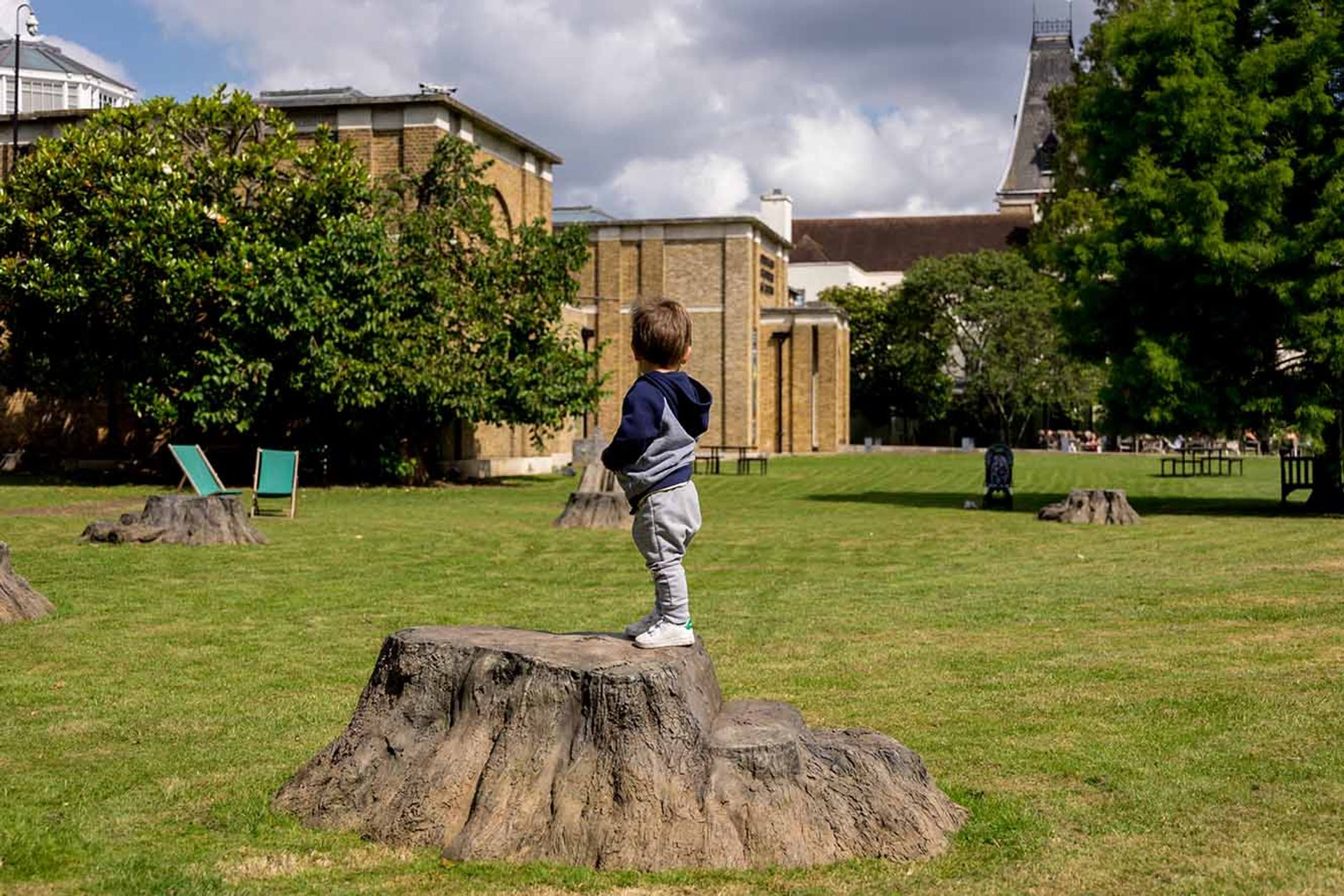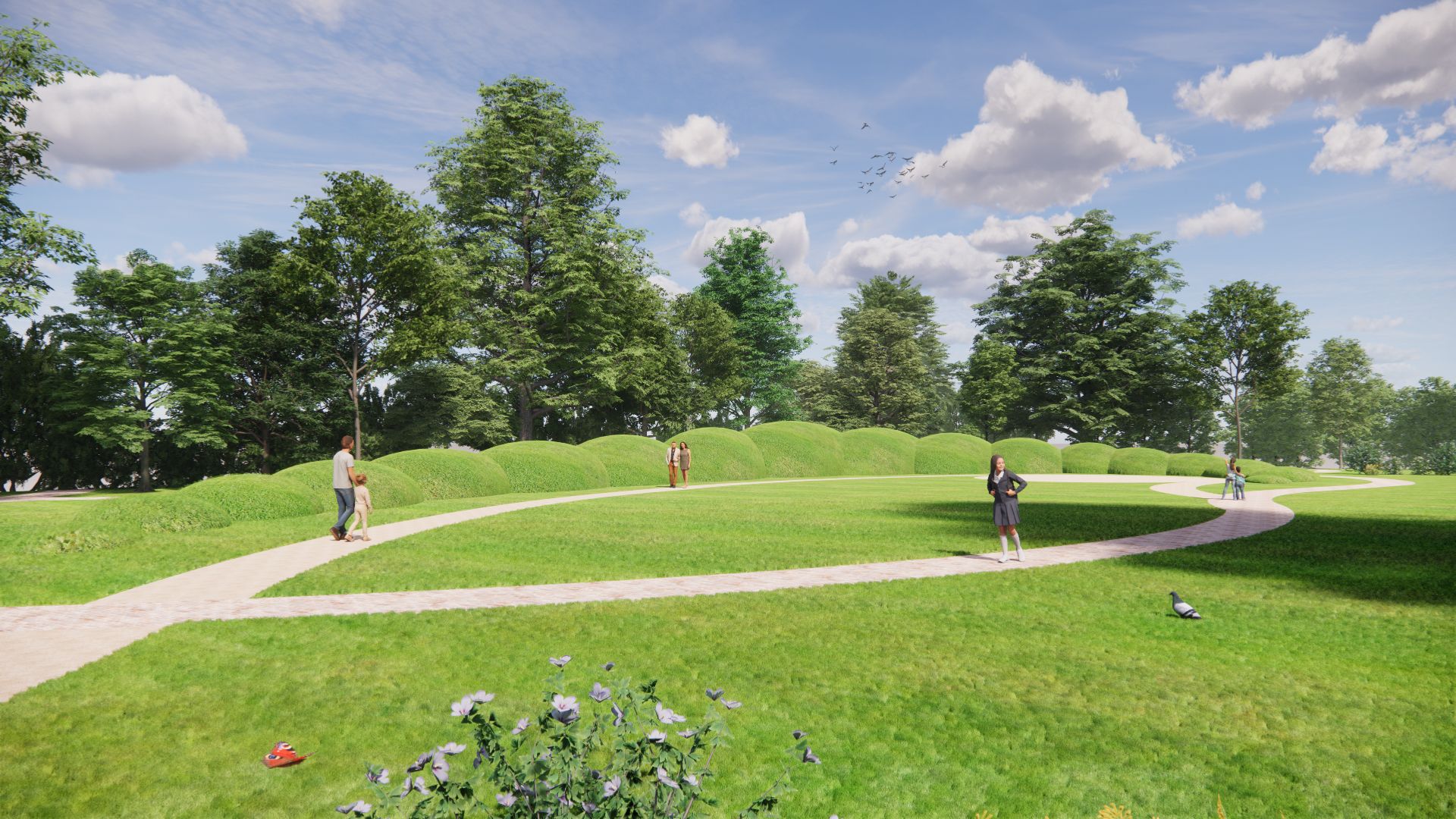Dulwich Picture Gallery, in south-east London, is famed for its collection of Old Master paintings, such as Rembrandt’s Girl at a Window (1645) and Nicolas Poussin’s The Triumph of David (1631). In recent years, however, sculpture and installation has played an increasingly important role—from site-specific works commissioned for the mausoleum, a central feature of the John Soane-designed building, to works of art and temporary pavilions erected in its grounds.
Now, the world’s oldest purpose-built art gallery has taken this a step further, announcing an ambitious £5m redevelopment of its three acres of outdoor space. Titled Open Art, the initiative will feature a rotating programming of contemporary art, creating what the gallery describes as London’s “first gallery-based sculpture garden”. The first works—a vibrant, twisting sculpture by Yinka Shonibare, and five biomorphic bronze and glass pieces by Li Li Ren, are already in place, and more will emerge over the next two years.

Yinka Shonibare CBE RA’s Material (SG) IV (2023) and Li Li Ren’s To find a way home (2023) in Dulwich Picture Gallery’s grounds Photo: Graham Turner
Open Art goes beyond that, too, placing emphasis on multi-faceted engagement with its community. In consultation with local families and groups, for example, the gallery is developing a dedicated pavilion for children under eight, where there will be workshops, exhibitions and other events. Another part of the gardens is being reimagined as the Lovington Sculpture Meadow, housing more than 100 newly planted trees and wildflowers such as oxeye daisy.
The project is expected to be complete by 2025. It is, the gallery’s director Jennifer Scott says, more than anything about “people, and inspiring people”. She spoke to The Art Newspaper about the process of making it all happen.
The Art Newspaper: How did the Open Art project come about?
Jennifer Scott: I think I saw there was a missed opportunity. A London-based gallery with three acres of green space is a rarity—so it felt very natural to focus on it.
We began with Rob and Nick Carter’s Bronze Oak Grove (2017), which we’re aiming to acquire as part of the programme. We’re not government-funded, we don’t have the funds to be doing acquisitions left, right and centre, so our curator here, my trustees and I, we thought it would be the right thing to acquire a hero piece, to kickstart the idea of Open Art, and also to test it. So we’ve had it in place on loan for a few years and visitors of all ages really enjoy it—the fact you can sit on it and do your stretches on it when you’re going for a jog and kids can do bronze rubbings.

A young visitor enjoying Rob and Nick Carter’s Bronze Oak Grove (2017) Photo: Graham Turner
So we’re hopeful this could be the acquisition piece. There will be one commission which we’re working with the London Festival of Architecture on, which is a playable sculpture. And then the other works are going to be loans.
A key part of the project is the creation of what the gallery describes as London’s “first gallery-based sculpture garden”. How are you defining that?
That’s a tricky one. I think my preferred way of talking about it is that we’re creating a sculpture garden with a difference. By which I mean we are taking stories from within our collection and our really quirky building, and sharing them outside in the gardens. We don’t want sculptures that are behind barriers; instead, we want them to be something that feels organic in the space: things you can play with, interact with, and that just feel fun.
Within that, we are looking at contemporary sculpture and particularly selecting artists where the stories within the sculptures can link back to who we are and what we’re about. Bronze Oak Grove is a great example. As soon as I saw that sculpture, it was like it was meant to be because it brings to life a 17th-century Dutch drawing by Jacob de Gheyn—and we have the portrait by Rembrandt of his son, Jacob de Gheyn III. So that link was just magical.
How have you approached the loans?
Our curator Helen Hillyard started having lots of conversations with contemporary artists, contemporary galleries. We feel very strongly that we’ve got a great historic collection in our care, but within gardens, we want to look at contemporary artists, including those who come from different backgrounds, so female artists, artists from different racial backgrounds.
We have also worked together with Frieze Sculpture. Fatoş Üstek, the director of Frieze Sculpture, gave us lots of advice as well. It’s not necessarily an official partnership with Frieze, but it’s definitely working together with them.
Can you tell me a bit about the first two loaned works, by Li Li Ren and Yinka Shonibare, and how they connect to the collection?
Li Li Ren’s work is a sculpture in five parts, which is really nice because it also makes you think, what is a sculpture? Is it just one piece? I think you often think of it like that. It also takes inspiration from coral reefs from the ocean, and so the link there that we’re drawing out is texture and the feeling of, for instance, if you’re looking at water going over rocks in a Jacob van Ruisdael, you feel you want to touch them.

Li Li Ren’s To find a way home (2023) takes inspiration from coral reefs Photo: Graham Turner
Yinka’s work is six metres tall—it’s like a beacon. If you’re in two minds about coming into our gardens, it is just calling you in. It resembles material floating in the wind, and when we’re doing our talks indoors and out at the gallery, we can pull out more of the sense of material that is in the painting, so we could link it to our Murillo Flower Girl (1665-70) and look at the material in the clothing in our Tiepolo. It offers a way of getting our visitors to think about stuff and substance indoors and out.
In terms of interaction that you mention. How will that work in practice?
It’s a good question. The one sculpture we already had in the collection is Peter Randall Page’s Walking the Dog (2008-10). And the great joy of that sculpture is that it can be sat on and clambered on. And Bronze Oak Grove too. With the other works it’s not about clambering and swinging on them, but they need you to activate it. We talk about how here we bring life to art and art to life, and that’s part of what this is about: that actually the sculpture doesn’t exist if you’re not looking at it and being part of it.

Peter Randall Page’s Walking the Dog (2008-10) is one of the gallery’s fully climbable sculptures Photo: Graham Turner
Are there any other works of art confirmed for the gardens at this time?
There is one in the Lovington Sculpture Meadow, a permanent feature in a field at the back of the gardens, a part that people don’t normally see. I’ve always called it the field of missed opportunity, and we’re turning it into the meadow of dreams.
Within the meadow, the landscape architect Kim Wilkie has created a land earthwork that takes inspiration from The Girl at a Window by Rembrandt. The girl has a sort of plaited clasp that holds our chemise together and the land earthwork is formed to resemble a plait. It will have wildflowers on it in the first year and behind that, we’re planting 130 trees to become an “art forest”.

A rendering of the Levington Sculpture Meadow, designed by Carmody Groarke. The meadow will also feature a new ground-source heat pump, aimed at reducing the gallery’s carbon emissions Courtesy of Kim Wilkie
Can you tell me about some of the work you are doing for young audiences?
We were thinking about what we could do in our space for families, and the idea for the Art Play space was born. Carmody Groarke are the architects: it’s got big circular windows looking out into the garden, so very much embedded in nature, which is a big thing we learned from temporary pavilion projects.

A rendering of the Children’s Play Gallery, designed by Carmody Groarke. Beside it, a keeper’s cottage will also be converted to house facilities such as a schools’ lunch room Courtesy of Carmody Groarke
That space is going to be bringing to life the historic paintings from our collection through play. We’re working with play consultants who are doing loads of testing and seeing what works within the space, but for instance, imagine Jacob’s ladder, in our 18th century Dutch painting by Arent de Gelder. You will slide down Jacob’s ladder, you’ll skip across Canaletto’s Walton Bridge, Poussin’s clouds. So it’s literally bringing the paintings alive. We’re really excited about it.
What have been some of the big challenges in putting this together?
Well, I think the constant pressure is that unlike other museums and galleries in London, we’re not government or local authority funded (though we did have an emergency government grant in the pandemic, which was amazing). That’s compounded by the fact that we look like we’re wealthy. We look as if we are somehow government funded, as if we’re sitting on pots of money.
So I think that’s the biggest challenge is that in a normal year, we’re raising at least £1.3m. So to then launch a £5m project on top of that is challenging. It’s also really inspiring though, and the team here, we do everything together. Every time we get a £10,000 grant, we’re kind of all cheering. It’s genuinely like that.
Have you had to be a bit more creative with funding?
We have knocked on every door and we’ve had a few slammed—nicely—in our faces because there’s so much competition. And we just keep going.
There are some new funders. There is the Manton Foundation, for example, an American organisation, who don’t fund many people in the UK. We are also selling a print, Lemon, by Robin Nick Carter: all the proceeds of that go to support the project, so that’s fantastic.
There’s something scary about the process, but if you’re not a little bit afraid, then I don’t think you’re challenging yourself enough. It’s just trying to keep that balance right, that we’re not being reckless, that we’re doing something that we know the audiences are there for. So for the Art Play Space, for instance, that’s not an arbitrary choice. That’s knowing that our children’s and families’ activities are oversubscribed at the moment. And while it’s a ticketed experience, we’re making sure that two days a week it’s free for community use.
As the oldest public gallery in the world, do you do you feel you have a responsibility to be thinking creatively and to be changing in this way?
Being entrepreneurial is absolutely the spirit of this place. Our founders—Noël Desenfans and Sir Francis Bourgeois—thought outside the box. They had this art collection on their hands that hadn’t been paid for by the King of Poland, and they came up with this new idea and brought in their friend Sir John Soane, to design an art gallery to house the works. I’m always thinking: would the founders have approved of this?
And if it’s a little bit quirky, if it’s creatively inspiring, if it’s something that will really open up art for audiences, then that’s what we’re about. That’s what we’ve been doing for over 200 years.

